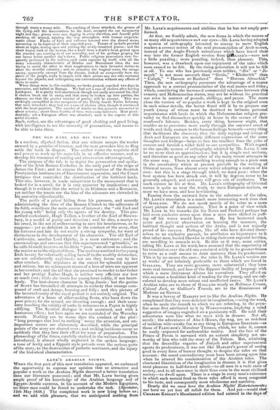THE OLD EARL AND HIS YOUNG WIFE
Is a random, slipshod fiction, that one minute tempts the reader onward by a promise of interest, and the next provokes him to fling aside the book in disgust. The author wants the requisite skill and power to work up his materials in an effective manner, and to develop his resources of reading and observation advantageously.
The purpose of the tale is to depict the persecution and spolia- tion of the Irish Roman Catholics in the early part of the reign of James the First ; and to expose the base motives of the Scottish Presbyterian instruments of Government oppression, and the Court intrigues that controlled the distribution of the forfeited lands. This aim, however, is made subservient to the amusement that is looked for in a novel, for it is only apparent by implication ; and though it is evident that the writer is an Irishman and a Romanist, yet neither the tenets nor the bias of the advocate are obtruded in his narrative objectionably.
The perils of a priest hiding from his pursuers, and secretly administering the rites of the Roman Church to the adherents of its faith, constitute the main source of interest ; the "old Earl and his young wife" being only the agents of his destiny. This pro- scribed ecclesiastic, Hugh Talbot, a brother of the Earl of Shrews- bury, is a model of purity and devotion ; and he dies, a martyr to his creed, in the act of endeavouring to save his benefactress, as he supposes : yet so deficient in art is the conduct of the story, that his fortunes and fate do not excite a strong sympathy, for want of distinctness in the development of his character. The old Earl of Carthwaite, another Lord Ogleby, is a mere caricature ; and the eaterwaulings and caresses that this superannuated "grimalkin," as he calls himself, bestows on his little "puss," are almost as odious to the reader as to the object of them. The motives ascribed to theyoung Irish beauty for voluntarily selling herself to the wealthy debauchee, are not satisfactorily explained; nor are they borne out by her after conduct. She stipulates at the outset for splendid apparel and retinue, but no subsequent traces of a love of state are apparent in her conduct ; and the aid that she promised to render to her father and her protégé Father Hugh, is neither very efficient nor lent at much cost ; while she treats her young lover coldly, if not heart- lessly. The best-drawn character is King Jamie: but the genius of SCOTT has forestalled all attempts to embody that strange com- pound of craft and dotage, learning and folly ; and this picture of the besotted vanity of the royal pedant is not entirely original. The adventures of a brace of siller-seeking Scots, who hunt down the poor priests for the reward, are diverting enough ; and their casu- istry touching the validity of oaths in reference to a Papist is highly edifying. The Scottish dialogue is well sustained, and with a humorous effect; but here again we are reminded of the Waverley novels. Nothing can be worse than the conduct of the plot : "long passages that lead to nothing" weary the attention, and un- important scenes are elaborately described, while the principal points of the story are slurred over ; and striking incidents occur so suddenly that they lose their effect for want of preparation. The phraseology of the times, carefully studied in the written documents introduced, is almost wholly neglected in the spoken language : a tone of levity and a flippant style pervade even the serious parts °fate story, to the destruction of pathetic sentiment, and the injury of the historical characteristics.


























 Previous page
Previous page